|
by Yukino Yoshi

 apanese animation genius Hayao MIYAZAKI wanted to make a film about hatred so as to show that there is more to life than hatred itself. He wanted to tell a story of a curse to show the joys in its liberation; an ecological epic where at the end, the girl can say to the boy "I love you, but I can't forgive humans." -- to which the boy smiles, "That's fine. Come live with me." apanese animation genius Hayao MIYAZAKI wanted to make a film about hatred so as to show that there is more to life than hatred itself. He wanted to tell a story of a curse to show the joys in its liberation; an ecological epic where at the end, the girl can say to the boy "I love you, but I can't forgive humans." -- to which the boy smiles, "That's fine. Come live with me."
And Hayao Miyazaki told his tale with his latest -- and possibly his last -- masterpiece. Mononoke Hime (Princess Spirit) opened to 250 theatres across Japan on July 12 this year, and has since grossed over $121 million. With already over 11 million viewers, Princess Mononoke has also broken the Japanese box-office record set by E.T. in 1982.
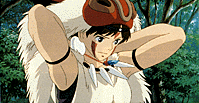 Mononoke Hime is an epic set in the Muromachi Period (1333-1568). A village, the Tataraba, is inhabited by women freed from forced prostitution and other hardships. Under the protection of Lady Eboshi, they continuosly mine the nearby forested areas for iron for their weapons. In the forests dwell however the animals, spirits and their gods, all of whom see the encroachment of the humans with much respite. Hatred soon runs deep with one battle after another. Mononoke Hime is an epic set in the Muromachi Period (1333-1568). A village, the Tataraba, is inhabited by women freed from forced prostitution and other hardships. Under the protection of Lady Eboshi, they continuosly mine the nearby forested areas for iron for their weapons. In the forests dwell however the animals, spirits and their gods, all of whom see the encroachment of the humans with much respite. Hatred soon runs deep with one battle after another.
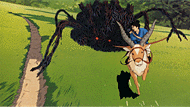 San is the princess raised by the wolves in the forest, and her contempt for the humans is no less. Ashitaka is a young warrior with a curse that is slowly killing him, and he has come to Tataraba in search of a cure. Both meet in battle on different sides, but soon falls in love. And as it gets bloodier with each battle, both San and Ashitaka have to find a way to stop the hatred before it is too late.
San is the princess raised by the wolves in the forest, and her contempt for the humans is no less. Ashitaka is a young warrior with a curse that is slowly killing him, and he has come to Tataraba in search of a cure. Both meet in battle on different sides, but soon falls in love. And as it gets bloodier with each battle, both San and Ashitaka have to find a way to stop the hatred before it is too late.
Relating the past to the present
Unlike the Disney flicks from the west, Mononoke Hime is not a tale about good and evil, but rather one about balancing the need for social change and preservation. It is at times an uncompromising ecological tale which Miyazaki stresses is not too different from our current times.
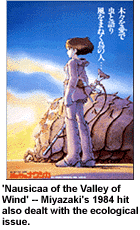 "The relationship between the Japanese and nature has changed greatly over the centuries, becoming what is today around the time of the Muromachi Era." Miyazaki said. "While holding nature in awe, the Muromachi people approved the cutting down of trees...people came to feel they could control nature. I've come to a point where I just can't make a movie without addressing the problem of humanity as part of an ecosystem."
"The relationship between the Japanese and nature has changed greatly over the centuries, becoming what is today around the time of the Muromachi Era." Miyazaki said. "While holding nature in awe, the Muromachi people approved the cutting down of trees...people came to feel they could control nature. I've come to a point where I just can't make a movie without addressing the problem of humanity as part of an ecosystem."
In truth, Mononoke Hime is not the first time a Studio Ghilbi (or Miyazaki) film has taken on the 'eco-message'. When his fledging career as the creative master in Studio Ghibli began in 1984, Miyazaki's first film Nausicaa of the Valley of Wind tells of the conflict between humans and gigantic insects, and one girl's unflailing determination to stop it. Nausicaa took in US$6.45 million, and went on to earn a cult following in both east and west.
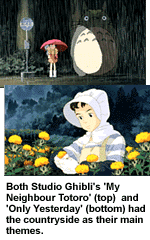 In 1988, Miyazaki then released My Neighbour Totoro, a charming tale about two sisters who meet a fuzzy mononoke which then shows them the beauty of the nature around them. The movie was released on video in 1994 in the U.S., and has made sales of about 560,000 units. It has also be translated into various languages in other parts of Asia.
In 1988, Miyazaki then released My Neighbour Totoro, a charming tale about two sisters who meet a fuzzy mononoke which then shows them the beauty of the nature around them. The movie was released on video in 1994 in the U.S., and has made sales of about 560,000 units. It has also be translated into various languages in other parts of Asia.
A few other Studio Ghibli films also have nature for their themes. Pom Poko [1994] is about a community of groundhogs fighting to preserve their homes from the industrial changes during postwar Japan, while Only Yesterday (Omohide Poro Poro) [1991] tells of one woman's love for the country.
Even the 1996 release Whispers of the Heart (Mimio Sumaseba) [1996] speaks of a kind of fascination with the romantic despite having the story set in Tokyo today.
Page 1 | Page 2 | Page 3
Mononoke Hime, Nausciaa of the Valley of Wind, My Neighbour Totoro, Pom Poko, Only Yesterday, and Whispers of the Heart are all trademarks of Studio Ghibli. Images used herein are also copyright of Studio Ghilbi.
Web design and article by Yukino Yoshi.
|











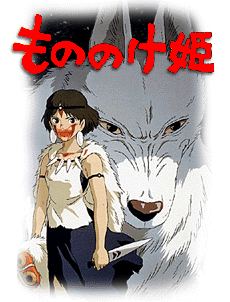

 apanese animation genius Hayao MIYAZAKI wanted to make a film about hatred so as to show that there is more to life than hatred itself. He wanted to tell a story of a curse to show the joys in its liberation; an ecological epic where at the end, the girl can say to the boy "I love you, but I can't forgive humans." -- to which the boy smiles, "That's fine. Come live with me."
apanese animation genius Hayao MIYAZAKI wanted to make a film about hatred so as to show that there is more to life than hatred itself. He wanted to tell a story of a curse to show the joys in its liberation; an ecological epic where at the end, the girl can say to the boy "I love you, but I can't forgive humans." -- to which the boy smiles, "That's fine. Come live with me."
 Mononoke Hime is an epic set in the Muromachi Period (1333-1568). A village, the Tataraba, is inhabited by women freed from forced prostitution and other hardships. Under the protection of Lady Eboshi, they continuosly mine the nearby forested areas for iron for their weapons. In the forests dwell however the animals, spirits and their gods, all of whom see the encroachment of the humans with much respite. Hatred soon runs deep with one battle after another.
Mononoke Hime is an epic set in the Muromachi Period (1333-1568). A village, the Tataraba, is inhabited by women freed from forced prostitution and other hardships. Under the protection of Lady Eboshi, they continuosly mine the nearby forested areas for iron for their weapons. In the forests dwell however the animals, spirits and their gods, all of whom see the encroachment of the humans with much respite. Hatred soon runs deep with one battle after another.
 San is the princess raised by the wolves in the forest, and her contempt for the humans is no less. Ashitaka is a young warrior with a curse that is slowly killing him, and he has come to Tataraba in search of a cure. Both meet in battle on different sides, but soon falls in love. And as it gets bloodier with each battle, both San and Ashitaka have to find a way to stop the hatred before it is too late.
San is the princess raised by the wolves in the forest, and her contempt for the humans is no less. Ashitaka is a young warrior with a curse that is slowly killing him, and he has come to Tataraba in search of a cure. Both meet in battle on different sides, but soon falls in love. And as it gets bloodier with each battle, both San and Ashitaka have to find a way to stop the hatred before it is too late.
 "The relationship between the Japanese and nature has changed greatly over the centuries, becoming what is today around the time of the Muromachi Era." Miyazaki said. "While holding nature in awe, the Muromachi people approved the cutting down of trees...people came to feel they could control nature. I've come to a point where I just can't make a movie without addressing the problem of humanity as part of an ecosystem."
"The relationship between the Japanese and nature has changed greatly over the centuries, becoming what is today around the time of the Muromachi Era." Miyazaki said. "While holding nature in awe, the Muromachi people approved the cutting down of trees...people came to feel they could control nature. I've come to a point where I just can't make a movie without addressing the problem of humanity as part of an ecosystem."
 In 1988, Miyazaki then released My Neighbour Totoro, a charming tale about two sisters who meet a fuzzy mononoke which then shows them the beauty of the nature around them. The movie was released on video in 1994 in the U.S., and has made sales of about 560,000 units. It has also be translated into various languages in other parts of Asia.
In 1988, Miyazaki then released My Neighbour Totoro, a charming tale about two sisters who meet a fuzzy mononoke which then shows them the beauty of the nature around them. The movie was released on video in 1994 in the U.S., and has made sales of about 560,000 units. It has also be translated into various languages in other parts of Asia.